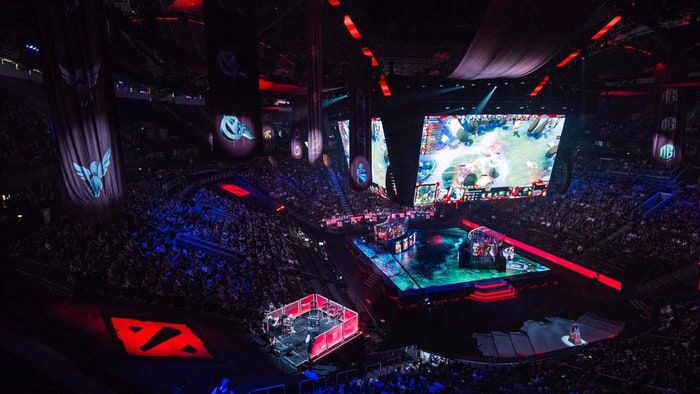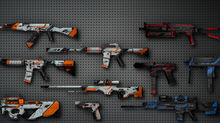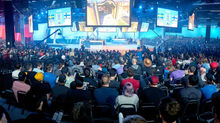The International: How to Watch the Biggest Esports Tourney in History
- Play4Win
- Aug 4, 2017
- 11 min read
Prize pool is more than $23 million

After months of preparation and a rising tide of anticipation that has spilled over into every corner of esports, The International 7, the seventh iteration of Dota 2’s premiere event, begins today in Seattle. It is, by prize money, the largest esports tournament in history, and is expected to draw in well over 20 million viewers from across the globe. So if you’ve ever been curious about esports but didn’t know where to start, there’s never been a better time to get your feet wet than The International.
We won't try to teach you how to play Dota 2 (we'd be here all year if we did), but here’s a primer to get you started on watching the game like a pro.
What is The International? The International – formally known as The International Dota 2 Championships 2017, but “TI7” for short – is the Super Bowl of Dota 2. Hosted each year in Seattle by the game’s publisher, Valve, it is an esports extravaganza that draws in fans from all over the world, and, over time, it’s become a kind of Hajj for the Dota 2 community. At the time of writing, this year’s prize pool is approaching $23,000,000, over $10,000,000 of which will go to the winning team.
Wait, how is it possibly worth that much? Unlike the League Championship Series, The International isn’t funded by corporate sponsorships or media rights (for now at least). Outside of different teams’ own sponsors, you’ll see never see a logo or a branded segments on stream. Instead, Valve pays for the event via crowd funding. Each year, the company releases a Battle Pass (previously known as the Compendium), an interactive booklet filled with goodies that players can buy and spend money to level up. A portion of the proceeds from Battle Pass sales goes to funding the prize pool, and it’s something of a tradition among Dota 2 fans to try to outdo the previous year’s outlandish sum.
For better or worse, the massive size of the event has a warping effect on the competitive Dota 2 scene, making it difficult for third party organizers to gain relevance. Consequently, players are more and more dependent on the prize money from The International. This year, the prize pool is worth more than three times every other event in 2017 combined. Not everyone thinks this is healthy, but it helps explain the outsize influence that The International hold over on the Dota 2 scene.

How is the event structured? The International 7 is split into two sections, the group stage, which start today, and the main event, which takes place next week. For the group stage, which takes place at Valve’s headquarters in Bellevue, WA and is not open to the public, teams are divided into two groups of nine. Each team plays a two game series against every other team in their group and is awarded one point for each win. At the end of the group stage, the top four teams in each group advance to the upper bracket of the playoffs, while the fifth through eighth place teams move to the lower bracket. The last place team is eliminated.
Per tradition, the main event (i.e. the playoffs) will take place in Seattle’s KeyArena. Over six days, the remaining sixteen teams will play through a double elimination playoff bracket. Every series is a best of three, with two exceptions. The first round of the lower bracket is a high-stakes best-of-one, while the grand finals is a best of five.
Who is playing, and how did they get there? There are 18 teams competing in Seattle from six regions: Europe, North America, South America, the Commonwealth of Independent States (CIS, A.K.A. former Soviet republics), China, and Southeast Asia. Teams could qualify in one of two ways. Six teams received direct invites to The International based on their performance since the last International, while the other 12 teams were forced to qualify through a series of regional competitions.
Years ago, China was considered the strongest region by far in large part due to the widespread popularity of the game in the country, as well as its superior esports infrastructure. These days, the field is a lot more even, but China is still by far the most well-represented region. Most Dota 2 fans would consider Europe to be the second strongest region, while CIS and North America are just behind that. Over the last year, Southeast Asian teams have made large strides, while South America has earned a spot at the International for the first time in history.
So who’s going to win? That’s tricky. Because even a great team wins only around 70 percent of its games, Dota 2 is notoriously resistant to predictions. But, for simplicity's sake, let’s group the teams into three categories.

The "definitely-could-win" teams:
Evil Geniuses – If I had to pick a single team most likely to win, it would be Evil Geniuses. As Dota 2’s most well-funded and most prestigious organization, EG has some of the best players and support staff in the game. They’ve been consistently excellent throughout the year, and two of the team’s players, Saahil “Universe” Arora and Syed “Sumail” Hassan, have already won an International.
OG – A team of international fan favorites, OG is widely seen as one of the best teams in the world and has a reputation for playing especially well at premiere tournaments. Led by one of Dota 2’s most charismatic duos, Johan “N0Tail” Sundstein and Tal “Fly” Aizik, the team is as much loved for their affable mein as their in-game abilities.
Invictus Gaming – One of China’s longest-running Dota 2 organizations, Invictus Gaming already has one International to its name. Led by the always-never-actually-retiring legend Xu “Burning” Zhilei, iG is one of the most well-respected teams in China and a constant threat to win any tournament it enters.
Team Liquid – Alongside OG, Team Liquid is generally considered the other best team in Europe. Though their results haven’t always been consistent, they’ve been on an absolute tear this summer. Likewise, their middle lane virtuoso Amer “Miracle-” Al-Barkawi (who made his professional debut on OG) is constantly in contention for the title of best player ever, while the team’s captain, Kuro “KuroKy” Salehi Takhasomi, is considered one of the best shot-callers in the game.
Virtus Pro – The unquestioned best team in the CIS region, Virtus Pro is known as an extremely talented team that’s sometimes undone by its own superego and prone to bouts of infighting. At one tournament in June, they refused to draft any hero more than once to prove that they could win with unpopular heroes and strategies. That time it worked out for them, but no team has quite the Icarian hubris of Virtus Pro and many would love to see them fall on their faces.
Newbee – Champions of The International 4, Newbee is considered one of the best teams in China. They’re led by Zeng “Faith” Hongda, who is one of the longest-playing and most respected captains in China and, unlike Invictus Gaming, have already won two tournaments this summer.

The “could in theory win but probably won’t” teams:
Fnatic – Though Fnatic is technically based in the United Kingdom, it sponsors a (mostly) Malaysian Dota 2 team. Behind their perpetual rivals TNC Gaming, Fnatic is the probably the second best team in Southeast Asia. Though they haven’t won any major tournaments this year, they’re prone to pulling off unexpected upsets, making them more likely to be a spoiler than a champion.
Team Secret – Once considered one of the best organizations in the world, Team Secret’s luster has dimmed a little over the last year thanks to some high-profile departures and an ongoing cloud of scandal. Its current lineup is a motley quintet of European, Near Eastern, and Southeast Asian players led by the legendary Clement “Puppey” Ivanov, one of the oldest and most experienced players in the scene.
LGD Gaming – As one of China’s oldest Dota 2 organizations, LGD Gaming has competed with different lineups at every International since 2012. This year, they’re led by Yao Zhengzheng, a veteran of the Chinese scene who has been with the organization in one way or another since 2012.
LGD Forever Young – LGD Forever Young was originally founded as a “junior team” for LGD Gaming, but quickly proved itself of going toe-to-toe with its older sibling. The team is built from a compelling blend of aging veterans (e.g. Xie “Super” Yunhao) and young blood (Du “Monet” Peng), making them one of the quirkier teams in Chinese Dota 2.
TNC Gaming – Perpetually underestimated, TNC Gaming is generally considered the best team both in the Philippines and in Southeast Asia as a whole. Last year, they surprised the Dota 2 world by placing sixth at The International, and they’d like nothing more than to prove that their success was not a fluke.
Cloud9 – Built from a quintet of North American fan favorites previously playing under the name Team NP, Cloud9 is a talented team with a tendency to produce very strange (but exciting) games. Cloud9 has a complicated history in Dota 2, but fans are generally excited to see the company return to the game and hope that the team does well if only to encourage the organization to stay in the scene.

Finally, "the outsider" teams:
Infamous – Infamous is the first South American team to ever compete at The International, but are much weaker than their North American counterparts. For structural reasons, South America’s Dota 2 scene has lagged behind that of other regions, so the fact that there’s a Peruvian team in Seattle at all is already a major coup.
Hellraisers – Previously known as Planet Dog, Hellraisers is more-or-less a pickup team of European misfits who made a team for The International’s qualifiers and somehow emerged victorious. Still, besides Infamous, they’re probably the weakest team in Seattle.
Execration – Because TNC Gaming has become the poster team for Dota 2 in the Philippines, neither Execration nor its players are very well-known outside of the country. Consequently, expectations are low for Execration.
Digital Chaos – Formed by a group of North American Dota 2 players who weren’t invited to join more established teams, Digital Chaos managed to piece together enough victories to earn a spot in Seattle. Their star player, Abed Azel Yusop, emigrated from the Philippines to the United States to play with DC, and is widely seen as a rising star in Dota 2, no matter how his team ends up doing.
Team Empire – Because Virtus Pro is so well-funded, they’ve had their pick of the best players in CIS Dota 2 for some time, leaving Team Empire picking up the scraps. As a result, Team Empire’s lineup is an eccentric band of oddballs that haven’t really distinguished itself this year.
iG Vitality – Like LGD Forever Young, iG Vitality is Invictus Gaming’s junior team. Because most of iG Vitality’s players are very young, none of them have much of a reputation beyond the Chinese scene. For better or worse, they’re a “black box” going into The International 7.

So let’s say I start watching. What the hell am I looking at?
Dota 2 is an extraordinarily complex game, and its user interface reflects that. You won’t understand everything that’s going on in your first or second game. In fact, you won’t understand everything that’s going on ever, which is part of Dota 2’s enduring appeal.
If that’s intimidating, fear not. The International 7 is running a “newbee” stream in which shoutcasters will announce each game as if the viewer is completely new to Dota 2. If you’re not a regular player, that’s your best bet. The stream will also feature a number of extra overlays aimed at demystifying as much of the game as possible. What’s more, the host of that stream, Kevin “Purge” Godec is something of a guru in the Dota 2 community and his guide, “Welcome to DotA! You suck” is by far the most famous resource for teaching new players.
I’ll let Purge and his co-casters do most of the explanatory work, but let’s quickly walk through the game’s UI.
So, clockwise starting at 12:00, you can see portraits for 10 heroes, five on each side. On the left side are “Radiant”’s heroes (defending the bottom half of the map), and on the right is those of Dire (defending the top). The numbers between them indicate how many kills each team has scored. In this case, Radiant has 17 kills and Dire only have eight. Most of the time, the kill score a good indicator of who’s winning. In between those is a game clock, as well as a day-night cycle indicator.
In the lower right-hand corner is a small panel that shows a hero’s current gold (754, in our example) and their “shopping list.” In Dota 2, heroes gain a trickle of gold passively and earn it actively by killing enemy creeps, heroes, and structures. The row of items above the current gold indicator shows the items and components a player intends to buy (think of it as a wish list – in indicates what they want to purchase, but it’s not in anyway binding).

At 6:00 is the most information-saturated part of Dota 2’s UI, the hero panel, which displays (almost) everything you need to know about whatever hero the observer has selected. On the far left is an animated hero portrait, as well as a numerical overlay showing a hero’s vitals – attack speed, armor, damage, move speed, etc. To the right of that are buttons representing a hero’s abilities, the rightmost of which is a hero’s “ultimate.” (In our example, the third skill is grayed out because the player hasn’t leveled it up yet). Below that are a green bar and a blue bar representing a hero’s current health and mana, respectively. Finally, to the right of that is a 3x3 grid of boxes that display a hero’s current items. The two upper rows show a hero’s active items, while the lower three represent a hero’s Backpack, where players put items they aren’t using (currently, Pudge doesn’t have anything in his Backpack, which is why the boxes are empty).
In the bottom left corner is the minimap, which is divided into two halves, Radiant (lower half) and Dire (upper half), and trisected by three lanes (top, bottom, middle). Green markers represent Radiant heroes, towers, wards, and units, while red ones represent those of Dire. The white rectangle highlights whatever section of the map the in-game camera is trained on, which allows you to orient whatever you’re looking at on the map at large. If you’re ever lost, the lower side of the map (Radiant) is themed as good (flowers, green grass, squirrels etc.), while Dire is themed as evil (crooked trees, lifeless dirt, snakes).
Finally, in the upper left corner is a series of 10 horizontal bars that display different kinds of information about each hero, like current level, buyback status, K/D/A, etc, in relation to those of other heroes. During the first 10 minutes of the game, this panel usually shows how many last hits each hero has earned, organized from most (top) to least (bottom). After that, it will generally display the Net Worth of each hero, which adds a hero’s current gold to the value of their items.

So how and when do I watch? There are lots of ways to watch The International, but the easiest way is through Twitch, YouTube, or Steam Broadcasting. Every format is completely free and will be for the entire event.
During the main event, there’s only a single match happening at once, so it’s very easy to keep track of the tournament. During the group stage, however, multiple matches run concurrently. The official schedule is listed here, and the “live” tab of The International’s webpage will always direct you to whatever game you’re interested in. Personally, though, I like to keep an eye on the Dota 2 directory on Twitch, which shows every active Dota 2 stream (whether in English or not). The title of each stream reflects the match taking place therein, letting you quickly navigate between different broadcasts so you can see the matches you want to see.
Spoiler free replays for every match are available here.
For viewers new to Dota 2, I humbly suggest picking a single team and trying to follow as many of their games as you can. Not only will this help you recognize certain players and their playstyles, but you’ll also develop an attachment to the team over time. If you’re at a loss of who to pick, OG, Team Liquid, and Evil Geniuses are good all bets because they’re likely to do well, have distinctive in-game strategies, and are led by charismatic players.
You can also watch The International for free through the Dota 2 client, which is also free. And in the event that you’re a virtual reality enthusiast, you can watch every match of The International in the Dota 2 VR Theater.
Finally, if you’d rather not watch at home, many bars (gaming-themed or not) will host viewing parties for some or even all of the main event. Colloquially, these are known as “Pubstomps” and it’s not uncommon for Valve to send swag bags to the larger events. There’s almost always at least one Pubstomp in major cities; to find one near you, you can use this website. Happy viewing!













































Comments